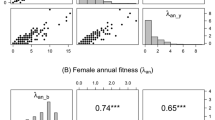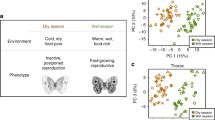Abstract
Global climate change is shifting many species’ phenology and has created a number of key mismatches that threaten population persistence. Phenotypically plastic individuals have the ability to adjust their behaviour in response to environmental change. While phenotypic plasticity may serve as a buffer, it is generally not known whether in case this plasticity is insufficient there is additive genetic variation in the phenological trait so that populations’ may also show an evolutionary response. We show that hibernation emergence date of yellow-bellied marmots (Marmota flaviventer), a trait that has been significantly advancing in recent years and is associated with increased spring temperature, is phenotypically plastic. Furthermore, we used the quantitative genetic ‘animal model’ to decompose variation in emergence date and show there is significant heritable variation. We infer that so far phenotypic plasticity has allowed marmots to track the environmental changes leading to earlier emergence and suggest that in the short run, marmots may be able to continue to plastically respond to environmental change and thus that this trait potentially can evolve when the plasticity no longer buffers the selection for earlier emergence.
Similar content being viewed by others
Data accessibility
Data and code are available on the OSF: https://doi.org/10.17605/OSF.IO/924PK.
References
Armitage KB (1998) Reproductive strategies of yellow-bellied marmots: energy conservation and differences between the sexes. J Mammal 79:385–393
Armitage KB (2003) Reproductive competition in female yellow-bellied marmots. In: Ramousse R, Allainé D, Le Berre M (eds) Adaptive strategies and diversity in marmots. Lyon, International Marmot Network, pp 133–142
Armitage KB (2014) Marmot biology: sociality, individual fitness, and population dynamics. Cambridge University Press, Cambridge
Armitage KB, Downhower JF, Svendsen GE (1976) Seasonal changes in weights of marmots. Am Midl Nat 96:36–51
Armitage KB, Wolff J, Sherman P (2007) Evolution of sociality in marmots: it begins with hibernation. Rodent societies: an ecological and evolutionary perspective. University of Chicago Press, Chicago, pp 356–367
Atmeh K, Andruszkiewicz A, Zub K (2018) Climate change is affecting mortality of weasels due to camouflage mismatch. Sci Rep 8:1–7. https://doi.org/10.1038/s41598-018-26057-5
Blondel J, Thomas DW, Charmantier A, Perret P, Bourgault P, Lambrechts MM (2006) A thirty-year study of phenotypic and genetic variation of blue tits in mediterranean habitat mosaics. Bioscience 56:661–673. https://doi.org/10.1641/0006-3568(2006)56[661:atsopa]2.0.co;2
Blumstein DT (2009) Social effects on emergence from hibernation in yellow-bellied marmots. J Mammal 90:1184–1187
Blumstein DT (2013) Yellow-bellied marmots: Insights from an emergent view of sociality. Philos Trans R Soc B Biol Sci. https://doi.org/10.1098/rstb.2012.0349
Blumstein DT, Im S, Nicodemus A, Zugmeyer C (2004) Yellow-bellied marmots (Marmota flaviventris) hibernate socially. J Mammal 85:25–29. https://doi.org/10.1644/1545-1542(2004)085<0025:ymmfhs>2.0.co;2
Blumstein DT, Lea AJ, Olson LE, Martin JGA (2010) Heritability of anti-predatory traits: vigilance and locomotor performance in marmots. J Evol Biol 23:879–887. https://doi.org/10.1111/j.1420-9101.2010.01967.x
Both C, Visser ME (2001) Adjustment to climate change is constrained by arrival date in a long-distance migrant bird. Nature 411:296–298. https://doi.org/10.1038/35077063
Boutin S, Lane JE (2014) Climate change and mammals: evolutionary versus plastic responses. Evol Appl 7:29–41. https://doi.org/10.1111/eva.12121
Bradshaw WE, Holzapfel CM (2001) Genetic shift in photoperiodic response correlated with global warming. Proc Natl Acad Sci U S A 98:14509–14511. https://doi.org/10.1073/pnas.241391498
Floyd CH (2004) Marmot distribution and habitat associations in the Great Basin. West North Am Nat 64:471–481
Gezon ZJ, Inouye DW, Irwin RE (2016) Phenological change in a spring ephemeral: implications for pollination and plant reproduction. Glob Change Biol 22:1779–1793. https://doi.org/10.1111/gcb.13209
Hadfield JD (2010) MCMCglmm: MCMC methods for multi-response GLMMs in R. J Stat Softw 33:1–22. https://doi.org/10.1002/ana.22635
Imperio S, Bionda R, Viterbi R, Provenzale A (2013) Climate change and human disturbance can lead to local extinction of Alpine rock ptarmigan: new insight from the Western Italian Alps. PLoS One 8:1–11. https://doi.org/10.1371/journal.pone.0081598
Inouye DW, Barr B, Armitage KB, Inouye BD (2000) Climate change is affecting altitudinal migrants and hibernating species. Proc Natl Acad Sci U S A 97:1630–1633. https://doi.org/10.1073/pnas.97.4.1630
Jones AG, Ardren WR (2003) Methods of parentage analysis in nautral populations. Mol Ecol 12:2511–2523. https://doi.org/10.1046/j.1365-294X.2003.01928.x
Kalinowski ST, Taper ML, Marshall TC (2007) Revising how the computer program CERVUS accommodates genotyping error increases success in paternity assignment. Mol Ecol 16:1099–1106. https://doi.org/10.1111/j.1365-294X.2007.03089.x
Körtner G, Geiser F (2000) The temporal organization of daily torpor and hibernation: circadian and circannual rhythms. Chronobiol Int 17:103–128. https://doi.org/10.1081/CBI-100101036
Kruuk LEB (2004) Estimating genetic parameters in natural populations using the “animal model". Philos Trans R Soc B Biol Sci 359:873–890. https://doi.org/10.1098/rstb.2003.1437
Kruuk LEB, Hadfield JD (2007) How to separate genetic and environmental causes of similarity between relatives. J Evol Biol 20:1890–1903. https://doi.org/10.1111/j.1420-9101.2007.01377.x
Kudo G (2014) Vulnerability of phenological synchrony between plants and pollinators in an alpine ecosystem. Ecol Res 29:571–581. https://doi.org/10.1007/s11284-013-1108-z
Lane JE, Kruuk LEB, Charmantier A, Murie JO, Coltman DW, Buoro M, Raveh S, Dobson FS (2011) A quantitative genetic analysis of hibernation emergence date in a wild population of Columbian ground squirrels. J Evol Biol 24:1949–1959. https://doi.org/10.1111/j.1420-9101.2011.02334.x
Lane JE, Czenze ZJ, Findlay-Robinson R, Bayne E (2019) Phenotypic plasticity and local adaptation in a wild hibernator evaluated through reciprocal translocation. Am Nat 194:516–528. https://doi.org/10.1086/702313
Maldonado-Chaparro AA, Martin JGA, Armitage KB, Oli MK, Blumstein DT (2015) Environmentally induced phenotypic variation in wild yellow-bellied marmots. J Mammal 96:269–278. https://doi.org/10.1093/jmammal/gyu006
Maldonado-Chaparro AA, Read DW, Blumstein DT (2017) Can individual variation in phenotypic plasticity enhance population viability? Ecol Model 352:19–30. https://doi.org/10.1016/j.ecolmodel.2017.02.023
Mills LS, Zimova M, Oyler J, Running S, Abatzoglou JT, Lukacs PM (2013) Camouflage mismatch in seasonal coat color due to decreased snow duration. Proc Natl Acad Sci U S A 110:7360–7365. https://doi.org/10.1073/pnas.1311224110
Montgomerie R (2001) Dirty ptarmigan: behavioral modification of conspicuous male plumage. Behav Ecol 12:429–438. https://doi.org/10.1093/beheco/12.4.429
Nussey DH, Postma E, Gienapp P, Visser ME (2005) Selection on heritable phenotypic plasticity in a wild bird population. Science 310:304–306. https://doi.org/10.1126/science.1117004
Ozgul A, Childs DZ, Oli MK, Armitage KB, Blumstein DT, Olson LE, Tuljapurkar S, Coulson T (2010) Coupled dynamics of body mass and population growth in response to environmental change. Nature 466:482–485. https://doi.org/10.1038/nature09210
Petelle MB, Martin JGA, Blumstein DT (2015) Heritability and genetic correlations of personality traits in a wild population of yellow-bellied marmots (Marmota flaviventris). J Evol Biol 28:1840–1848. https://doi.org/10.1111/jeb.12700
Polgar CA, Primack RB, Williams EH, Stichter S, Hitchcock C (2013) Climate effects on the flight period of Lycaenid butterflies in Massachusetts. Biol Conserv 160:25–31. https://doi.org/10.1016/j.biocon.2012.12.024
Post E, Steinman BA, Mann ME (2018) Acceleration of phenological advance and warming with latitude over the past century. Sci Rep 8:1–8. https://doi.org/10.1038/s41598-018-22258-0
Radchuk V, Reed T, Teplitsky C, Van De Pol M, Charmantier A, Hassall C, Adamík P, Adriaesen F, Ahola MP, Arcese P, Avilés JM, Balbontin J, Berg KS, Borras A, Burthe S, Clobert J, Dehnhard N, De Lope F, Dhondt AA, Dingemanse, NJ, Doi H, Eeva T, Fickel J, Filella I, Fossøy F, Goodenough AE, Hall SJG, Hansson B, Harris M, Hasselquist D, Hickler T, Joshi J, Kharouba H, Martínez JG, Mihoub J-B, Mills JA, Molina-Morales M, Moksnes A, Ozgul A, Parejo D, Pilard P, Poisbleau M, Rousset F, Rödel M-O, Scott D, Senar JC, Stefanescu C, Stokke BG, Kusano T, Tarka M, Tarwater CE, Thonicke K, Thorley J, Wilting A, Tryjanowski P, Merilä J, Sheldon BC, Møller AP, Matthysen E, Janzen F, Dobson FS, Visser ME, Beissinger SR, Courtiol A, Kramer-Schadt S (2019) Adaptive responses of animals to climate change are most likely insufficient. Nat Commun 10:1–14. https://doi.org/10.1038/s41467-019-10924-4
Réale D, McAdam AG, Boutin S, Berteaux D (2003) Genetic and plastic responses of a northern mammal to climate change. Proc R Soc B Biol Sci 270:591–596. https://doi.org/10.1098/rspb.2002.2224
Reed TE, Jenouvrier S, Visser ME (2013) Phenological mismatch strongly affects individual fitness but not population demography in a woodland passerine. J Anim Ecol 82:131–144. https://doi.org/10.1111/j.1365-2656.2012.02020.x
Schwartz OA, Armitage KB, Van Vuren D (1998) A 32-year demography of yellow-bellied marmots (Marmota flaviventris). J Zool 246:337–346
Van Asch M, Salis L, Holleman LJM, Van Lith B, Visser ME (2013) Evolutionary response of the egg hatching date of a herbivorous insect under climate change. Nat Clim Change 3:244–248. https://doi.org/10.1038/nclimate1717
Van Vuren D, Armitage KB (1991) Duration of snow cover and its influence on life-history variation in yellow-bellied marmots. Can J Zool 69:1755–1758. https://doi.org/10.1139/z91-244
Visser ME (2008) Keeping up with a warming world; assessing the rate of adaptation to climate change. Proc R Soc B Biol Sci 275:1471–2954. https://doi.org/10.1098/rspb.2007.0997
Visser ME, Gienapp P (2019) Evolutionary and demographic consequences of phenological mismatches. Nat Ecol Evol 3:879–885
Visser ME, Gienapp P, Husby A, Morrisey M, De La Hera I, Pulido F, Both C (2015) Effects of spring temperatures on the strength of selection on timing of reproduction in a long-distance migratory bird. PLoS Biol 13:1–17. https://doi.org/10.1371/journal.pbio.1002120
Wadgymar SM, Ogilvie JE, Inouye DW, Weis AE, Anderson JT (2018) Phenological responses to multiple environmental drivers under climate change: insights from a long-term observational study and a manipulative field experiment. New Phytol 218:517–529. https://doi.org/10.1111/nph.15029
Wilson AJ (2008) Why h2 does not always equal VA/VP? J Evol Biol 21:647–650. https://doi.org/10.1111/j.1420-9101.2008.01500x
Wilson AJ, Réale D, Clements MN, Morrissey MM, Postma E, Walling CA, Kruuk LEB, Nussey DH (2010) An ecologist’s guide to the animal model. J Anim Ecol 79:13–26. https://doi.org/10.1111/j.1365-2656.2009.01639.x
Zimova M, Mills LS, Nowak JJ (2016) High fitness costs of climate change-induced camouflage mismatch. Ecol Lett 19:299–307. https://doi.org/10.1111/ele.12568
Zimova M, Hackländer K, Good JM, Melo-Ferreira J, Alves PC, Mills SL (2018) Function and underlying mechanisms of seasonal colour moulting in mammals and birds: what keeps them changing in a warming world? Biol Rev 93:1478–1498. https://doi.org/10.1111/brv.12405
Acknowledgements
We thank the many marmoteers who have contributed to the dataset over the years, the Blumstein lab and two anonymous reviewers for constructive comments on prior drafts.
Funding
D.T.B. was supported by the National Geographic Society, UCLA (Faculty Senate and the Division of Life Sciences), a Rocky Mountain Biological Laboratory research fellowship, and NSF-IDBR-0754247, DEB-1119660 and 1557130 (to DTB); and NSF-DBI 0242960, 0731346, and 1262713 (to the RMBL).
Author information
Authors and Affiliations
Contributions
JAM and DTB conceived the project, JGAM and DTB collected data, MNE organized and proofed the data, JGAM analyzed the data, all authors discussed results and wrote the MS.
Corresponding author
Ethics declarations
Conflict of interest
We declare we have no competing interests.
Ethical standards
Marmots were studied under annual permits issued by the Colorado Division of Wildlife (TR-917). All procedures were approved under research protocol ARC 2001-191-01 by the University of California Los Angeles Animal Care Committee on 13 May 2002, and renewed annually.
Additional information
Publisher's Note
Springer Nature remains neutral with regard to jurisdictional claims in published maps and institutional affiliations.
Appendix
Appendix
Boxplot of the mass the previous August as a function of age and sex categories in yellow-bellied marmots using 901 mass measurements from 516 individuals. The bold horizontal lines and notches represent the median and 95% confidence interval around the median. The top and bottom of the boxes are the 25% and 75% quartiles. The whiskers extend to 1.5 the interquartile range and points are potential outliers
Rights and permissions
About this article
Cite this article
Edic, M.N., Martin, J.G.A. & Blumstein, D.T. Heritable variation in the timing of emergence from hibernation. Evol Ecol 34, 763–776 (2020). https://doi.org/10.1007/s10682-020-10060-2
Received:
Accepted:
Published:
Issue Date:
DOI: https://doi.org/10.1007/s10682-020-10060-2





